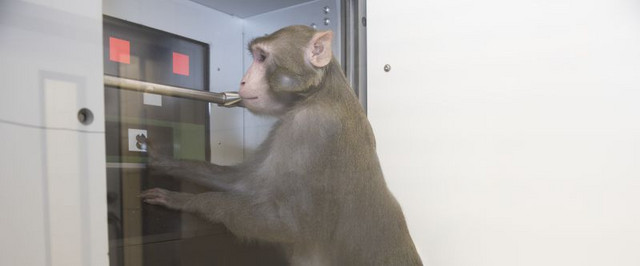Use curiosity and playfulness
Training with monkeys plays an essential role in neuroscientific research. For cognitive questions, for example, the animals are taught by positive reinforcement to solve complex tasks on screens. In other words, they are rewarded when they have done something right. However, training a rhesus monkey can take a lot of time and success depends on the motivation of the animal as well as the trainer's strategy. Usually, different monkeys are trained by different trainers with different strategies. This means that neither the training strategies nor the learning behavior of the animals can be compared. Scientists from the Cognitive Neurosciences Laboratory at the DPZ have therefore developed a standardized and automated training protocol that requires no monitoring by a trainer. The results were published in the Journal of Neurophysiology.
Initially, the researchers designed a new training device for the monkeys. The so-called eXperimental Behavioral Instrument, or XBI for short, makes it possible to train the monkeys on a touchscreen that can be attached to any enclosure. It allows that the animals can stay in their familiar home environment without leaving the group. Due to their natural curiosity, the animals learn the tasks in a playful way without the need for a trainer.
The scientists also designed the device so that an algorithm controls the learning progress. The more often the animal does the job correctly, the more difficult it becomes. To receive the reward, the animal must first touch a large square on the screen for just a moment. After a few successful interactions, the square becomes smaller and changes the position. As the training progresses, the tasks become more complex. Since the learning success of all monkeys is different, the computer adapts the training individually to the performance of the monkey -completely automatically and without human intervention.
The automation of the training protocol makes it possible to compare the learning behavior of monkeys. In this way, and the most curious and motivated animals can be identified leading to a better training success, and ultimately fewer animals are needed for the experiments. A positive side-effect: Automated training provides permanently a challenging task for the animal. This makes it neither boring nor too difficult and the monkeys remain motivated. The XBI with the new training protocol can therefore also be used as a toy to improve animal husbandry.
You can listen to a podcast of the journal in which the researchers explain their study here
Original publication
Berger M, Calapai A, Stephan V, Niessing M, Burchardt L, Gail A, Treue S (2017): Standardized automated training of rhesus monkeys for neuroscience research in their housing environment. Journal of Neurophysiology, DOI: https://doi.org/10.1152/jn.00614.2017
Calapai A., Berger M., Niessing M., Heisig K., Brockhausen R., Treue S., Gail A. (2016): A cage-based training, cognitive testing and enrichment system optimized for rhesus macaques in neuroscience research. Behavior Research Methods, 5, 1-11 https://doi.org/10.3758/s13428-016-0707-3

